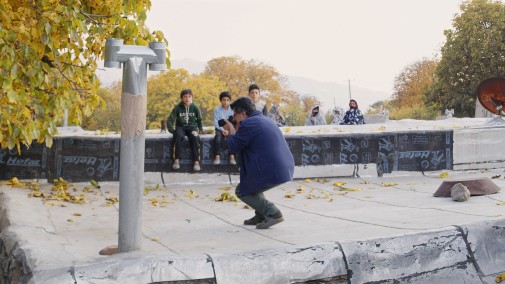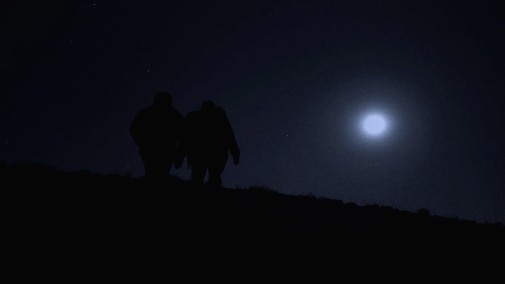Review: "No Bears" is new on VOD
 Wednesday, April 12, 2023 at 11:34AM
Wednesday, April 12, 2023 at 11:34AM 
One of 2022's most essential films, a title that will probably continue to accrue power in retrospect, is now available on VOD. It's none other than No Bears, Jafar Panahi's latest feat of illicitly-made cinema, premiered in Venice just as the director faced another period behind bars. He's since been released after announcing a hunger strike in protest. As with all of Panahi's creations since the 2010 sentence that resulted in a 20-year ban on moviemaking as decreed by the Islamic Revolutionary Court, it's challenging to approach No Bears as just another film. Well, that's logical since it's not just another film.
The picture's mere existence is an act of dangerous rebellion, a political gesture that can lead to dire consequences for its makers. Moreover, it's loaded with matters of metatextual and personal reflection that can only be understood within the context of the director's filmography. And yet, even in a vacuum, No Bears pulses with vitality, dark considerations on cinema itself. While Panahi grasps the freedom of creating, he will force you to consider the cost of creation. Haunting, it will persist in memory, growing more fascinating by the minute.

Unlike his countryman, fellow artist, inspiration, and departed collaborator Abbas Kiarostami, Jafar Panahi didn't start his cinematic career by telling stories within a rural milieu. Instead, much of his early output is two steps away from becoming city symphonies rhapsodizing through the streets of Tehran. It all started with realism among children in The White Balloon, growing into meta-cinematic gamesmanship in The Mirror. A rupture came as The Circle unearthed the political outrage boiling beneath the surface of those first features, exposing it as a tapestry of womanhood victimized by a misogynistic system. Offside tackles the same themes but finds hope at the end of the road.
Hope dies between Offside, and This Is Not a Film, with house arrest and the terrible ban. Fittingly, a sense of ragged rage makes the matter of cinema into a life-or-death situation. Locked in his apartment, Panahi's films transformed, giving way to a self-referential phase of his career, the director a character in all of his works. Closed Curtain is the artist's depression crystalized, Tehran abandoned for the Caspian shore. Taxi would bring him back to the city, but the pull of open spaces where one can disappear continued with 3 Faces and its blatant Kiarostami echoes. It was also a recovery of hope after the dark, a faint flame prone to be snuffed out.
No Bears doesn't put out the light, but it certainly complicates our view of it, once again pulling away from Iran's urban centers toward the rural communities near its borders.
This time, the character of Jafar Panahi is in the northernmost part of the country, staying at a small village close to a Turkish metropolis where his new movie's being shot in secrecy. The job of the cineaste is made by proxy, with Zoom calls serving as the only valuable connection between Panahi and his team. And yet, the wi-fi is terrible where he's staying, making one wonder why on earth he came here. Staying in his Tehran abode would have been better, not to mention safer for the banned artist. It may be about proximity, but to what exactly?

One gets a sense of both a cinema and a filmmaker on the verge of escape, yet something holds them back. In one harrowing nighttime sequence, freedom is a few steps away if only Panahi didn't stop dead in his tracks, returning to his fate in an act that's simultaneously enigmatic and viscerally felt deep in the audience's gut. It's selfish despite looking like self-abnegation, setting the stage for a cascade of tragedies that stem from one factor above all others – the camera and the man behind it. A staggering move, Panahi has twisted his usual presentation of himself and the work of cinema in these post-ban movies.
After decrying oppression and fighting it with the moving image, Panahi chooses to problematize his role as an artist whose work depends on other people. His effects on those collaborators, whether willing or not, can reverberate with a sting of oppression, turning them into collateral damage for a final objective that might not be worth it. The destructiveness isn't intentional, but that might be beside the point. When lives are wrecked, two storylines mirroring each other, one starts to feel bitterness on the tongue, mayhap the sour taste of guilt. Halfway between fact and fiction, ugly truths reside.
Shapeshifting with every couple of scenes, No Bears keeps playing tricks on the viewer. Some of them harken back to The Mirror's bifurcated playfulness. Others are akin to a confrontational conversation through which Panahi forces the audience to reassess their interpretation of the film and re-find their bearings over and over again.
Nevertheless, very little happens, like we're moving around in circles, limbo-like. Accusations of fakeness are thrown at the camera, a scorching direct-address monologue pointing to a compromised artistry that distorts reality into hollow lies. Parallel to that, a whole community is thrown in disarray by a photo we witness being taken but whose subjects are always out of frame. The actions of this director wandering while fictionalizing another's plight make things worse. The circle is now a siphoning spiral that ends in sorrow.
Then there's that porous barrier between documentary and narrative that has been a concern of Iranian filmmakers for decades. Panahi, in particular, has toyed with it to remarkable effect. Still, it has felt, in the past, like a joyous thing, on the verge of liberation. Looking at the story of No Bears, it appears as something that can be turned vicious in its deception, fortifying borders rather than transcending them.

We should ask ourselves - is making movies about making movies about making movies powerful art or a gimmicky provocation? Can one exist without the other, can political art make a positive difference for anyone? Is it tenable to feel responsible in this quandary? Is the boundary between tradition and bigotry comparable to the one that keeps the ideas of exile and escape separate, film and truth? So many questions asked, none of them answered. We're made to dialogue with Panahi through the screen, physical borders rhyming conceptual ones, to digest his uncompromising vision and all its thorny permutations.
No Bears is sharp and incisive, willing to pursue avenues of thought through deflections, winding down the road to honesty. Grappling with it isn't easy. It can be lacerating, and the film's open reticence frustrating. When cinema looks into a mirror, when it regards itself, we're used to encountering comfort. This time, however, we only find disquiet. There's value in that, brutal as it may seem.

Related reading:
 Iranian Cinema,
Iranian Cinema,  Jafar Panahi,
Jafar Panahi,  No Bears,
No Bears,  Reviews,
Reviews,  streaming
streaming 


Reader Comments (1)
The picture's very existence is a risky act of rebellion and a political statement that could have disastrous repercussions for those who created it. Additionally, it's replete with metatextual and reflective themes that can only be appreciated in the context of the director's oeuvre.
Best Dumpster Rental Company Near Me in USA